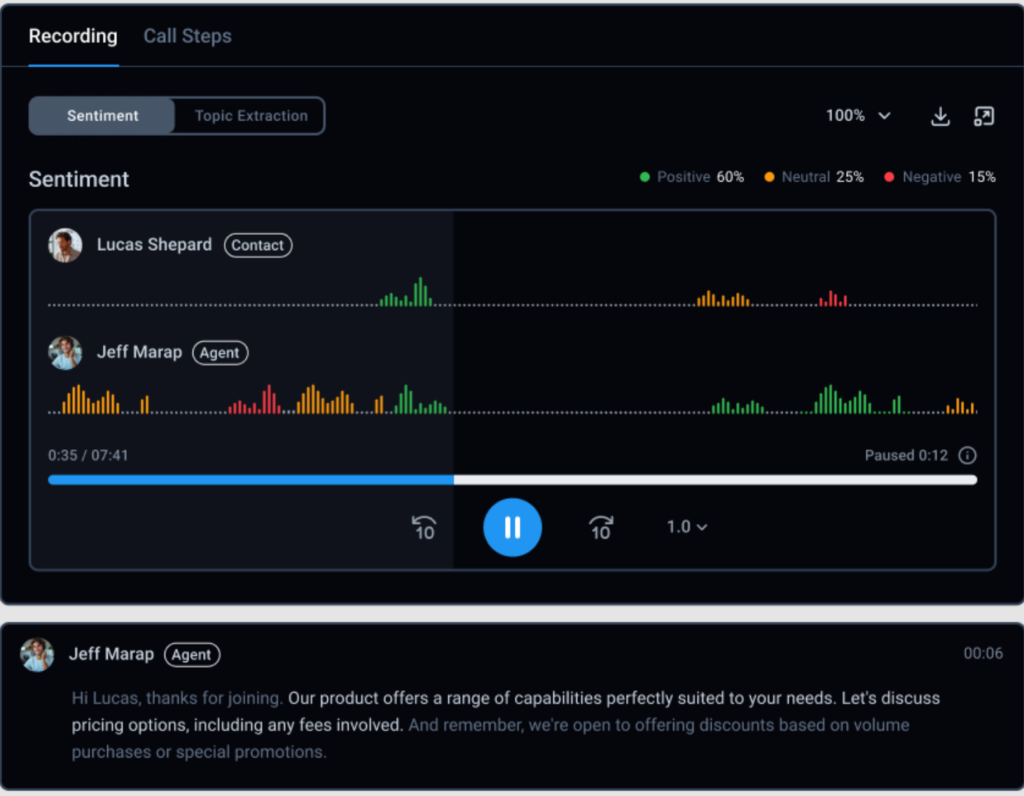
92% of customer interactions happen over the phone*. This means you need reliable phone systems that enable seamless communication, no matter where your team is located.
With Voice over Internet Protocol (VoIP) technology, businesses now have an affordable and flexible solution to meet this demand. In fact, small businesses can slash their starting costs by up to 90% by switching to VoIP*.
But as with any technology, VoIP systems have advantages and disadvantages. In this guide, we’ll explore what makes VoIP a game-changer—and where it might fall short—so you can decide if it’s the right choice for your business.
Key Takeaways:
- VoIP turns your internet-enabled device into a comprehensive communication hub, allowing you to make calls from anywhere and manage all your interaction requirements—from voice to email—in one place.
- Above all VoIP reduces costs, but also has other benefits, for example scalability and integration with key business tools such as Salesforce or Pipedrive.
- The main disadvantages of VoIP are its dependence on the internet and a stable power supply.
Cut missed calls by up to 40% with CloudTalk
Mastering VoIP: A Guide to Smart Communication
VoIP lets you make calls anytime from anywhere. All you need is a reliable internet connection and an internet-enabled smart device with a speaker and microphone.
Check out our video, which covers everything on VoIP:
Top Benefits of VoIP For Businesses
Whether your business is big or small, cost-saving opportunities are key. VoIP uses your existing internet service, cutting phone expenses by 45% and boosting productivity by 67%.
Let’s take a look at the direct and indirect cost savings VoIP can offer you.
Direct Cost Savings of VoIP
One of the biggest advantages of VoIP is its ability to eliminate the need for costly hardware and infrastructure. Here’s how:
1. Decrease PBX Costs
Traditional PBX systems require expensive hardware and setup. VoIP eliminates these costs by using your internet connection. Plus, with SIP trunking, you can easily upgrade to a cloud-based system without scrapping existing infrastructure. This makes it a cost-effective alternative to traditional phone systems.
2. Reduce Wiring Charges
VoIP allows voice and data transmission over the same channel, eliminating the need for extra wiring and reducing installation costs. Power over Ethernet (PoE) also promotes flexibility, enabling you to relocate staff without redoing the wiring. Plus, VoIP can be accessed via apps on computers and smartphones, cutting the need for physical phone lines.
3. Lower Calling Expenses
VoIP drastically reduces calling costs by offering lower data transmission rates. Both local and international calls are priced the same, meaning you can expand globally without incurring hefty fees.
4. Cut Maintenance Fees
VoIP systems bundle maintenance, repair, and subscription costs into a single, manageable fee, reducing recurring expenses. This subscription model makes VoIP particularly attractive for growing businesses, offering predictable costs without surprise fees.
It is the best VoIP call service that any company can count on, the calls are of very good quality, the services are very stable and the POST-sale service is the best, they are people who are always ready for any request or concern.
Johan Contreras, Support Engineer at RPS Processing Service
Indirect Cost Savings of VoIP
While indirect savings from VoIP are harder to measure, they are no less significant for your business’s bottom line. Here are some of the key areas where VoIP can have a long-term financial impact:
5. Save When Working Remotely
VoIP technology lets your employees easily connect to your company’s phone system from anywhere. This connectivity is supported by a suite of advanced features such as flexibility or multi-device compatibility that traditional telephones don’t usually offer.
For instance, cloud-based contact centers can reduce IT staff costs by 15% with VoIP.
6. Increase Flexibility
With softphones, you can make calls directly from a computer or mobile device and are no longer tied to a traditional office setup. This means you can handle customer calls, join conference calls, and access voicemail from every location.
Whether working from home, a hotel, or a cafe, your communication remains uninterrupted and your agents responsive.
7. Access A Portable Phone Number
VoIP numbers are fully portable, so you can keep the same number even if you change your location or business address. This is ideal for frequent business travelers and businesses in transition, which might undergo a strategic reorientation or do technological upgrades.
8. Enjoy Sound Quality and Ensure Call Quality
When assessing call quality, latency and jitter are the primary factors that influence the clarity of a conversation, ensuring voices are heard without distortion. If call quality deteriorates, the provider’s system automatically switches the call route in real-time.
Live monitoring ensures that calls are routed through the best possible channels and operators. VoIP technology can deliver crystal-clear audio, provided there’s a fast and stable internet connection. Your provider should be a registered operator in multiple countries, enabling direct control over various aspects of call quality.
9. Expand Your Communication Tools
By integrating voice calls, video chats, and messaging into a single platform, you improve team collaboration and make client meetings more productive and effective worldwide.
With VoIP, you can send images, videos, and documents during a call, making communication seamless and efficient.
10. Scale Effortlessly
Adjust your phone system to match business growth or seasonal changes without complex setups. VoIP systems are highly scalable, supporting large-scale, high-quality conference calls and the ability to add or remove users as needed.
11. Tailor Features to Your Needs
You can customize advanced features like Interactive Voice Response, Analytics, and Call Flow Designer to improve customer service and productivity.
This is especially useful for outbound sales teams and inbound customer support centers and service providers. For example, you can automate repetitive tasks like follow-ups, ticket creation, and call transcriptions. This saves your customer-facing teams time and lets them focus on delivering exceptional service.
Note
💡Pro tip: Use CloudTalk’s host of AI features to gauge customer sentiment during calls or extract key topics. This lets you better understand customer behavior and know exactly when to pivot or adjust your approach.

12. Integrate with Key Business Applications
Integrate VoIP with systems such as your CRM and business tools like Pipedrive, Salesforce, or HubSpot to optimize the flow of information and improve response times. By linking VoIP to these systems, you can automatically log calls, synchronize contacts, and ensure that valuable data is captured and easily accessible.
This integration is crucial for sales and service teams, offering immediate access to customer histories for personalized communication and quick problem-solving.
13. Ensure Communication Continuity
VoIP ensures communication continuity during emergencies or outages by allowing you to reroute calls to alternate devices or locations. This is crucial for businesses in disaster-prone areas or those that need to maintain constant communication during a crisis.
Main Drawbacks of VoIP You Should Know
1. Dependence on Internet Connectivity
VoIP is completely dependent on an internet connection. If your internet service suffers from low bandwidth or frequent interruptions, the quality and reliability of your calls may be affected.
During peak times, for example, your internet may slow down due to high traffic, which directly leads to poor voice quality or interrupted calls.
2. Power Outages
VoIP systems will not work during a power outage unless there is a backup power source, such as a generator or uninterruptible power supply (UPS).
This can affect business operations that rely on constant communication, especially in regions where power outages are frequent.
3. Emergency Calls Limitation
VoIP services sometimes do not connect directly with emergency service networks or correctly transmit location data.
This limitation could be critical if, for example, you attempt to call emergency services from a VoIP phone during a crisis at an unregistered location, potentially delaying the emergency response.
4. Security Vulnerabilities
Since VoIP operates over the internet, it’s vulnerable to cyber threats. Hackers could intercept VoIP calls or deploy malware to steal data. Businesses dealing with confidential information are particularly at risk if their VoIP system isn’t adequately secured.
5. Hardware and Setup Costs
VoIP is cost-effective in the long run, but the initial setup may require the purchase of IP phones, routers, or additional network hardware, which isn’t always cost-effective. This applies especially to businesses that also use landline infrastructure.
For small businesses, the initial costs may seem high, but they are often offset by lower operating costs in the long run.
Boost Efficiency and Cut Costs with CloudTalk’s VoIP
Communication issues have led 83% of companies to lose customers, miss deadlines, or lay off employees. This means investing in the right communication tools, like VoIP software, can significantly improve business performance while saving you money.
While VoIP has disadvantages like always requiring a stable internet connection, the pros outweigh the cons. For instance, VoIP lets you create a global presence with local numbers, cut operational costs, and improve team productivity.
Plus, with CloudTalk, you get advanced features like a Real-Time Dashboard that lets you monitor agent or group activity in real time. This gives you a unified solution where you can track anything from phone calls and performance metrics to agent availability—and improve overall efficiency.
Cut missed calls by up to 40% with CloudTalk

















